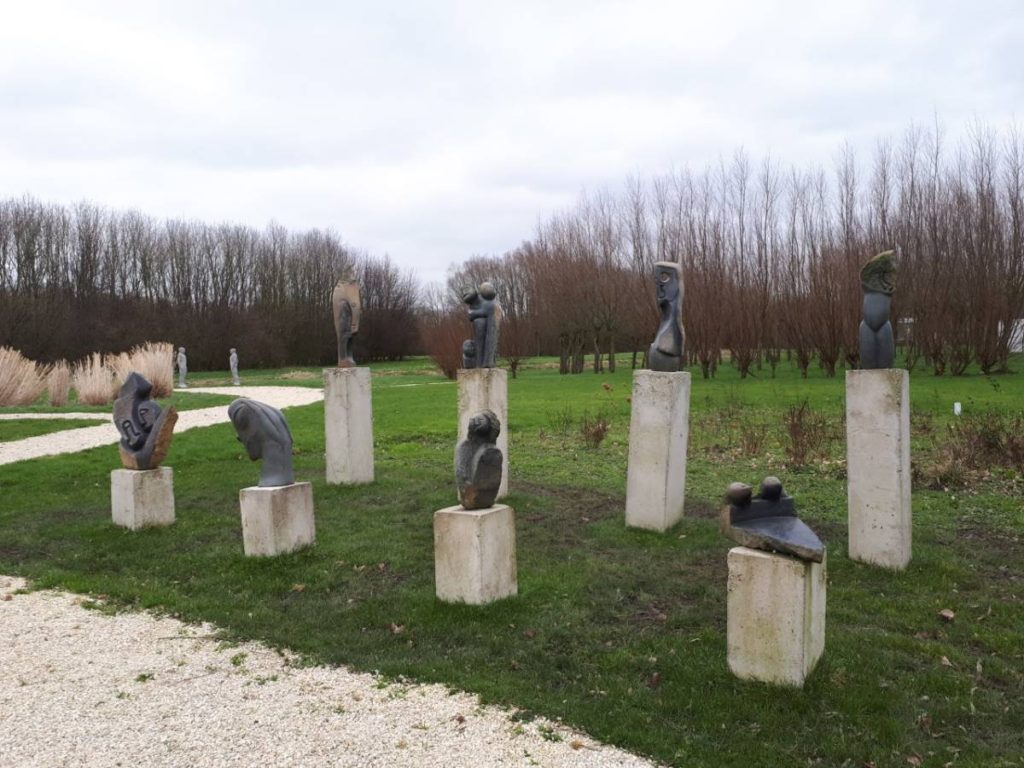Hortus Oculus- a Multi Sensory Garden
The art in the Hortus Oculus is an experience for all the senses. Our aim is to present a symbiosis between art and nature in a different way in this unique sculpture garden. The images are tangible, audible, visible and some of them can even be smelled.
International artists have each created a spacious work of art by invitation and after a selection especially for this multi-sensory garden. Some even multiple works of art. The 1st edition of artworks for the Hortus Oculus was created during the “Artist in Residence 2018”.
Land Art Delft has gained a lot of experience over the years in realizing works of art in this way. The artists spend a period at this inspiring location in the polder in order to develop their work in optimal conditions with professional support.
Artists Hortus Oculus:
- Toshitaka Nishizawa-Japan
- Kouji Ohno – Japan
- Els Otten – The Netherlands
- Dodog Soeseno – Indonesia
- Frank Eerhart – The Netherlands
- Marcel van Zijp – The Netherlands
- Paula Kouwenhoven – The Netherlands
- Gaku Hayashi – Japan
- Sarantis Gagas – Greece
Gaku Hayashi – Tree Impression
This Japanese artist is a student of Toshitaka Nishizawa who created the statue Navel of Darkness. Every time when Toshitaka came here to realize a work of art he took two assistants with him. In 2019 Gaku Hayashi was here with a colleague. After that work period Gaku wanted to stay longer to develop his own artwork. He wanted to make the view of the row of willows that had existed for years tangible for the visually impaired visitor by means of the material marble. With this work Gaku also depicted the distance between the trees, the distance that was once determined by the steps of farmer Jan, who planted the willows.
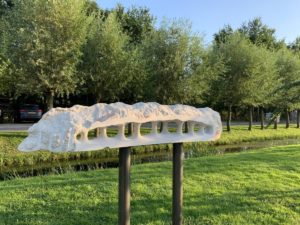
Paula Kouwenhoven – Willowhenge
Paula’s work ‘Willowhenge’ is inspired by Stonehenge and Woodhenge in England and the Woodhenge in the Millingerwaard along the Rhine. A circle of willows has been planted in the Hortus Oculus, the trees that so belong in this landscape. They are equidistant from each other and that creates a meditative atmosphere as you do the rounds in the circle, walking, smelling and listening to the waving of the willows in the wind. You feel at one with nature here. In Stonehenge the sun rises between the stones on June 21st, here the sun sets between the trees on June 21st.
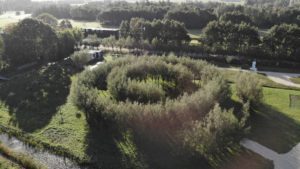
Marcel van Zijp – Crow
The tangible poetry in the image ‘Crow’ is a collection of selected fragments from a Schubert song text. The sentences are translated into English from the original ‘die Krähe’ (the crow) from the inimitable ‘Winterreise’ by this Austrian Romantic composer. Sculptor Van Zijp was fascinated by the emotion and unfulfilled desire of romance and the power of words. Fragments of sentences are beautifully carved vertically in the elongated block of Belgian bluestone.
The Crow: “A crow was with me. Out of town. Has constantly flew around my head until today. Crow, wonderful animal, Do you not want to leave me? Are you planning to grab my body as prey here quickly? Now, it won’t go far on this walking staff. Crow finally show me allegiance to the grave! “

Dodog Soeseno – Amazed
The spatial installation by Dodog Soeseno depicts the mythical garden. The artwork consists of a narrow vertical shelter on a round concrete circle that is painted like a carpet with cyan blue colored palpable flowers. In the introverted space, a universal visual language has been incorporated in ceramics. Sheltered from the wind you may find the echo of yourself. On top, colored decorated spheres in the colors red, yellow and blue adorn. The two tree branches in the shape of deer antlers on the side represent the growth of nature. See and feel also the paw prints of the sheep.
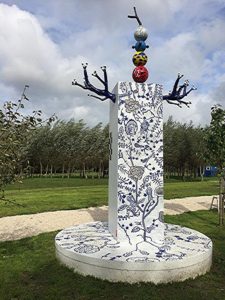
Kouji Ohno – Relational Connection
In honor of 75 years of Liberation this year, Kouji Ohno and microbiologist and researcher Henk Jonkers from TU Delft have created a new work of art for the Hortus Oculus with the theme “Liberation”. The artwork consists of a steel framework that refers to a composition by Piet Mondriaan and eight human figures that are isolated in the space while seeking connection with each other. The reference to freedom is the constant search for new ways to get in touch with each other and have mutual understanding without losing one’s identity.
Kouiji: ‘It expresses a symbol of peace that connects everyone and the world with multiple lines’.
Dr. Henk Jonkers is chair of the Sustainability research group of the Materials and Environment section at the Faculty of Civil Engineering and Sciences of the TU Delft. The artwork is a synergy between Japanese culture and modern environmental and materials science. The manifesto of a common fascination for human relationships, arts and crafts, nature, specific material properties expressed in living materials: innovative concrete. Kouji has investigated possible processing techniques to give the sculptures a human tangibility. The variety in concrete has been created specifically for these sculptures and is meant to inspire a unique material experience. The concrete human figures are all unique. This art experience provides insight into the future properties and applications of innovative concrete.
The steel is sponsored by the Huisman Equipment Schiedam company.
The artwork was unveiled on 14 August 2020 by Rector of TU Delft Tim van der Hagen.
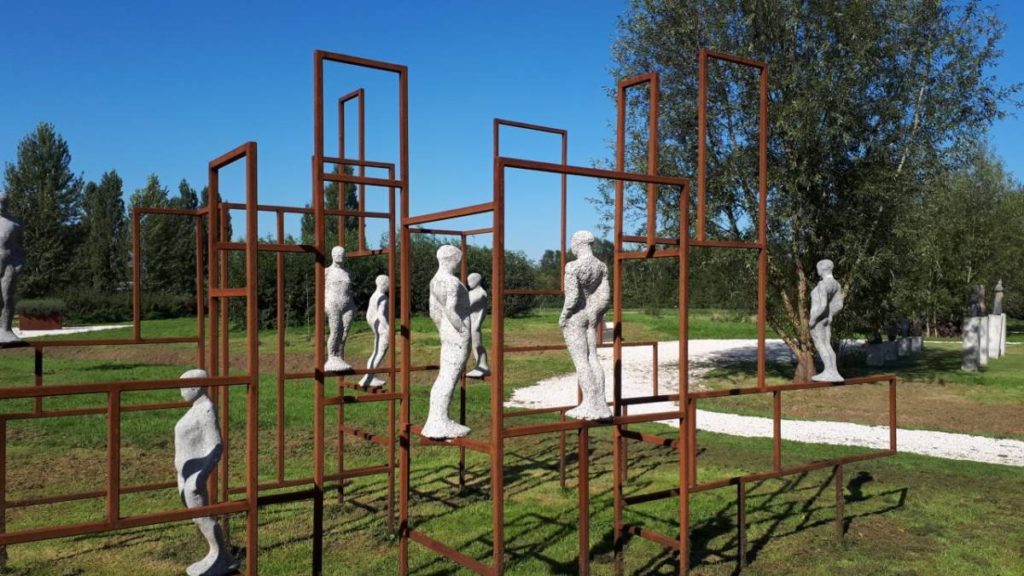
Toshitaka Nishizawa – Navel of Darkness
The Hortus Oculus opened in 2018 with the monumental sculpture Navel of the Darkness by the Japanese artist Toshitaka Nishizawa. The artwork immediately invites the visitor to an exciting approach: feeling, touching, caressing. The sense of touch is central. The image is of an unprecedented tenderness, sensual, vulnerable and earthly powerful and therefore an experience for the hand. A marble monolith, a rock that is millions of years old. It contains the eternity of nature, the slowness of time, the stillness of matter and the universe by touch.
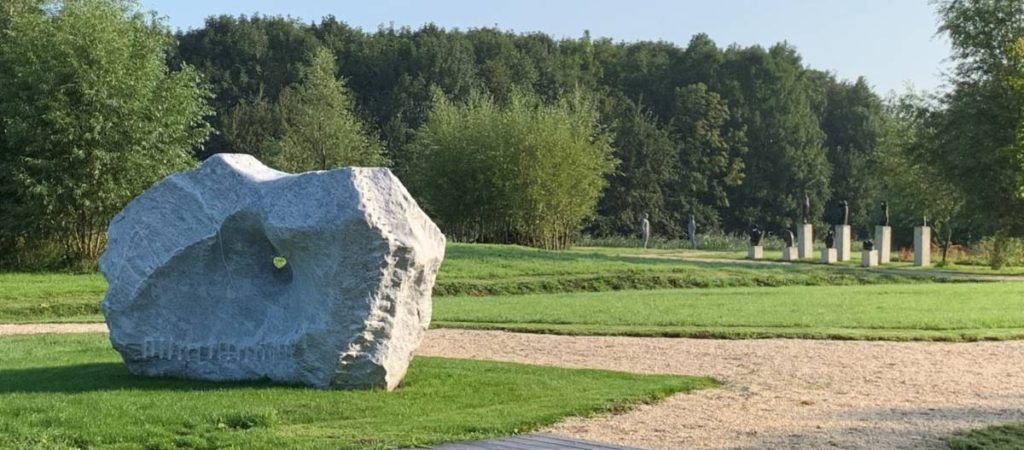
Sarantis Gagas – Landscape as a Memory
This work of art is a high garden that you can stand in front of, walk around and smell and feel, toss your hands through and stick your nose in. Landscape as a memory consists of three large elongated containers made of Corten steel, which is a raw material. In the summer, the containers contain Greek plants such as thyme, rosemary, lavender. Vincent Bijloo had also wanted nettle in it at the opening in 2018 for a tantalizing experience …. Who knows we will someday.

Frank Eerhart – Without wanting anything
In addition to being a poet and co-founder of Plint, Frank Eerhart is also a talented visual artist. These talents are combined in this work of art. ‘Without wanting anything’ is made of steel and stands on a round plateau. It is an assembly of found objects, four sticking stakes come together in a long pin surrounded by a flat circle. At the bottom is a poem by the artist visible and tangible about the relationship and the togetherness between humans and animals.
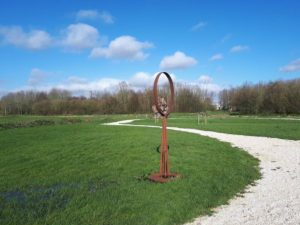
Marcel van Zijp – Aspidium Filix Mas
Marcel van Zijp’s second work is called ‘Aspidium Filix Mas’. The sculpture consists of a rough block of bluestone bearing a smoothly worked Belgian bluestone neck of a cello. The refined curl of the cello neck leads to the decorative piece: a beautifully designed scroll. It is a fine tangible work of art due to the contrast between rough and smooth. The translation of the Latin name ‘Aspidium Filix Mas’ is male fern, the plant that has just as beautiful a curl as the cello neck.
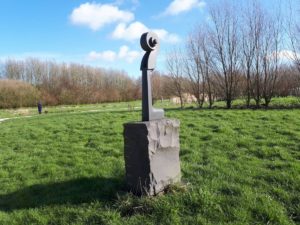
Els Otten – Tokashikijima Healing
The artist has been working with molten glass that has been solidified in molds for 10 years. This technique is called klincasting. Here a human figure partially made of blue Prosecco bottles seems to perish in the water. Or rising out of it?
Els Otten is inspired by corals that have washed up and found on the beaches of the Japanese island of Tokashikijima. The island has an eventful history.
The image requires a unique perception. The shape can be ‘seen’ in a different way through the shimmer of glass and water and can be experienced by the visitors, who can still somewhat distinguish light.
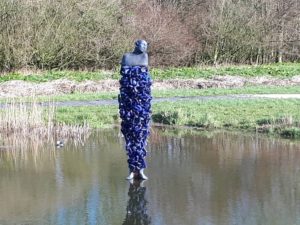
Toshitaka Nishizawa – As Is
The second artwork of this artist is formed by a steel cage with remains of an enormous sawn-down whiteHorse Chestnut. Many thought it was the tree from the garden of the Anne Frank house at Keizersgracht 188 in Amsterdam that fell in 2010, but that is not the case.
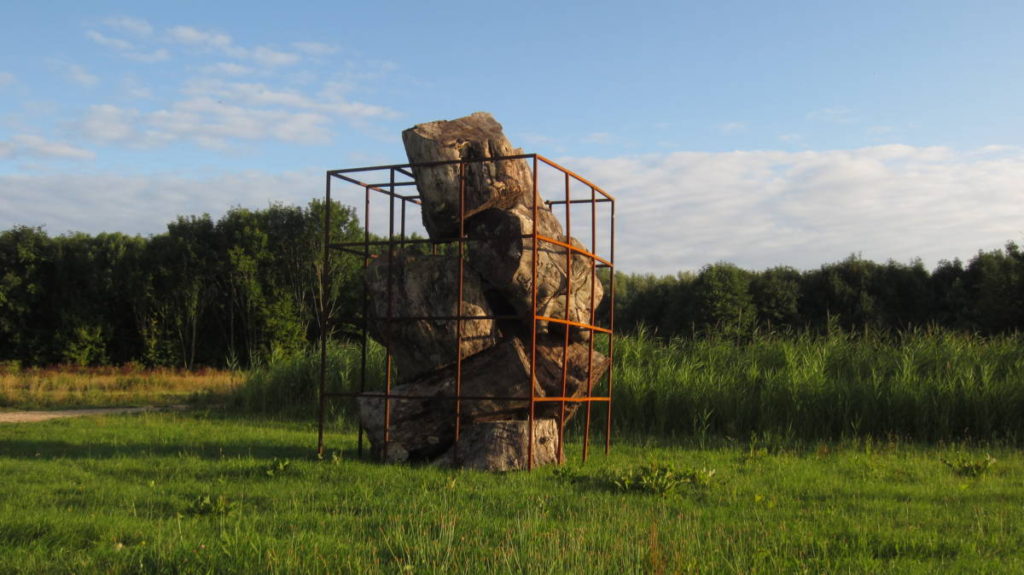
Kouji Ohno – In the beginning was the World
The second co- creation of Kouji Ohno and the microbiologist and researcher Henk Jonkers of TU Delft, develops also sculptures made of ‘smart materials’.
The two statues in the Hortus Oculus are not cast but made of Bio concrete, an innovative type of concrete. Bacteria (certain lichens) have been used that ensure that the concrete is self-healing. The technology is based on micro-organisms that produce limestone, so that cracks in concrete repair autonomously. The two images demonstrate this contemporary sustainable innovative technology. The first scale models were successfully presented in March 2018 during the TEDxDelft event.
The ‘human figures’, a male and female figure, are an introduction to a series of images in a variety of concrete and mosses. The structure of the female figure is noticeably slightly softer than the “skin” of the male figure. It shows a symbiosis of art and nature. The moss used for the sculptures could be seen as a reference to the Japanese Zen garden where mosses play an important role.
Read more:
“Self-healing bio concrete TU Delft nominated for European Inventor Award”
“Research on ‘green’ concrete”
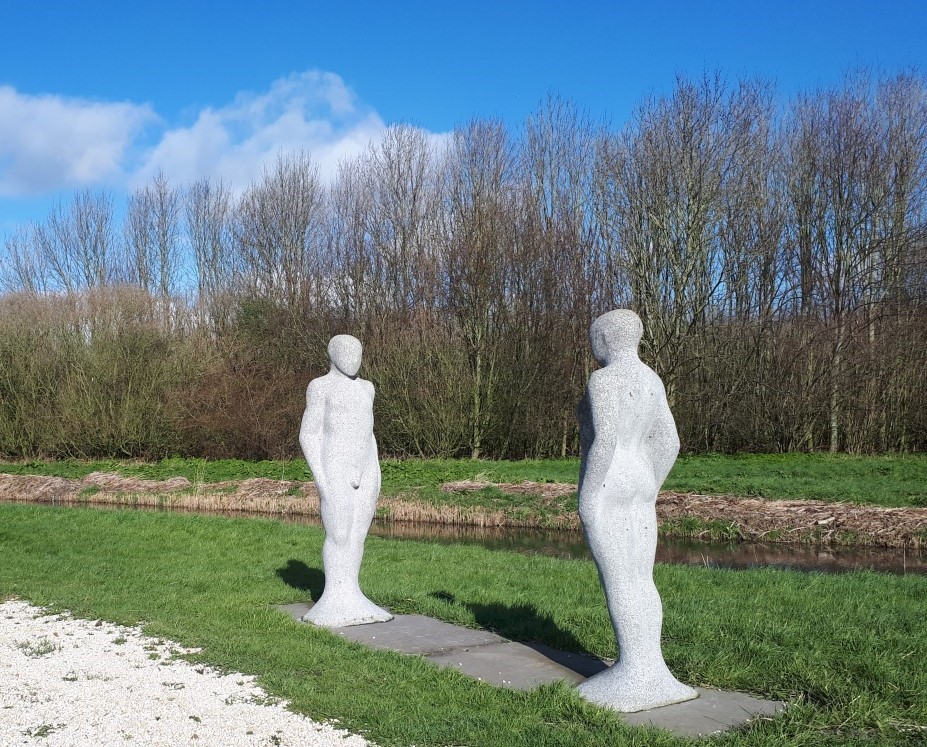
Paula Kouwenhoven – Lieu
Lieu means place and consists of a circle of willow trees in the sculpture garden. The circle acts as a large basket filled with lava stones. Anyone who wants to can add a stone with special memories of for instance happiness, sadness or annoyance.

Zimbabwe group
When friend Rob Rozenburg moved to Brussels with his gallery, a number of the gallery artworks were purchased by Land Art Delft. Eight works by Zimbabwean sculptors are now in the Hortus Oculus.
All eight statues are made of serpentine. The mineral serpentine is named after the Latin word serpens, which means ‘snake’. The shape in which the minerals have grown in the rock is reminiscent of the shape of a snake. It was also used in the past as a medicine against snake bites. Serpentine is mainly found in Zimbabwe. This is a very hard variety named Springstone and has a beautiful dark color. The name Zimbabwe literally means ‘house of stone’. The sculptures are fantastic to feel and to create your own fantasy. Round, angular, smooth and rough.
